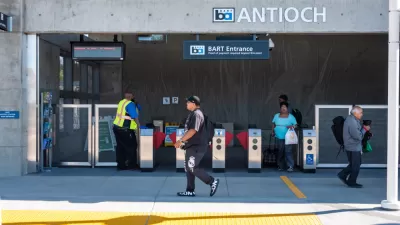The ballot measure generating the most new transportation funds approved by voters this month was in Alameda County, Calif. Voters chose to double an existing sales tax to one percent and extend it to 2045, raising $7.8 billion over 30 years.

While the transit win in Clayton County, Georgia. may have been the most significant, as the Atlanta-area county had "rejected a vote to join (Metropolitan Atlanta Rapid Transit Authority) MARTA back in 1971 and has struggled to provide good mass transit ever since—the latest blow coming in 2010, when a funding shortage forced its local bus system to stop running," as Eric Jaffe of Atlantic's CityLab writes (and also described here).
However, it was hardly the largest revenue producer. According to The Atlanta Journal‑Constitution, passage of the referendum "means Clayton’s sales tax will rise from 7 percent to 8 percent, starting in March. The MARTA tax is expected to generate proceeds of about $45 million per year."
By comparison, Alameda County Measure BB, by my calculation, will generate proceeds that average out to be about $260 million annually through 2045. Many other California counties and cities also passed significant transportation ballot measures on Nov. 4, including San Francisco's $500 million bond measure and MUNI population-based increase amendment, listed here by Melanie Curry of Streetsblog.
The prize for the biggest generator of transportation funds goes to Texas where voters "approved an amendment to increase state transportation spending by $1.2 billion to $1.7 billion a year," writes Governing's transportation reporter, Daniel C. Vock. However, while the funds may be new to the state's highway fund, they are hardly new tax dollars, as they are in Alameda County. Rather, voters authorized shifting the energy tax revenues from the state's rainy day fund, as noted here.
Denis Cuff, transportation reporter for the Contra Costa Times, writes that Measure BB "provides $3.7 billion for public transit and paratransit, $3 billion for road maintenance and freeway improvements, and $1 billion for bike and pedestrian improvements and transit-oriented development."
According to AC Transit, the East Bay public transit provider "will receive approximately $41 million per year in direct funding for bus operations, maintenance and safety, and approximately $9.9 million per year for East Bay Paratransit for seniors and people with disabilities. Measure BB could also fund capital improvements on AC Transit route."
The Bay Area Rapid Transit District (BART), the Bay Area's heavy rail network, received substantially less funding by comparison: $400 million for an extension to Livermore.
The measure, which needed to pass by two-thirds, received 69.56% of the vote. A similar measure barely missed the crucial 66.67% threshold two years earlier.
Another significant transit winner was in Seattle, where voters backed Proposition One that added a one-tenth of one percent sales tax and a $60 "car tab" (registration fee) to prevent (King County) Metro transit from slashing bus routes serving Seattle. Metro routes outside the city may still see cuts as county voters had rejected a bus funding measure in xxx, prompting Seattle Mayor Ed Murray and the Seattle City Council to act.
FULL STORY: Alameda County prepares to spend billions from increased sales tax

Study: Maui’s Plan to Convert Vacation Rentals to Long-Term Housing Could Cause Nearly $1 Billion Economic Loss
The plan would reduce visitor accommodation by 25,% resulting in 1,900 jobs lost.

Alabama: Trump Terminates Settlements for Black Communities Harmed By Raw Sewage
Trump deemed the landmark civil rights agreement “illegal DEI and environmental justice policy.”

North Texas Transit Leaders Tout Benefits of TOD for Growing Region
At a summit focused on transit-oriented development, policymakers discussed how North Texas’ expanded light rail system can serve as a tool for economic growth.

Paris Bike Boom Leads to Steep Drop in Air Pollution
The French city’s air quality has improved dramatically in the past 20 years, coinciding with a growth in cycling.

Why Housing Costs More to Build in California Than in Texas
Hard costs like labor and materials combined with ‘soft’ costs such as permitting make building in the San Francisco Bay Area almost three times as costly as in Texas cities.

San Diego County Sees a Rise in Urban Coyotes
San Diego County experiences a rise in urban coyotes, as sightings become prevalent throughout its urban neighbourhoods and surrounding areas.
Urban Design for Planners 1: Software Tools
This six-course series explores essential urban design concepts using open source software and equips planners with the tools they need to participate fully in the urban design process.
Planning for Universal Design
Learn the tools for implementing Universal Design in planning regulations.
Smith Gee Studio
Alamo Area Metropolitan Planning Organization
City of Santa Clarita
Institute for Housing and Urban Development Studies (IHS)
City of Grandview
Harvard GSD Executive Education
Toledo-Lucas County Plan Commissions
Salt Lake City
NYU Wagner Graduate School of Public Service





























